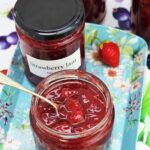
Homemade Strawberry Jam
A beautiful, soft-set strawberry jam filled with luscious pieces of whole fruit.
Ingredients
- 1 kg strawberries, washed and hulls removed weight after hulling
- 750 - 1000 g jam sugar (i.e. sugar containing pectin) see Recipe Notes #1 and #2
- 1 lemon juice only
Instructions
-
Put 2 or 3 small saucers in the freezer; they'll be used to quickly cool teaspoons of jam to find when the setting point has been reached.
-
Wash 4 jam jars and their lids in hot soapy water, rinse, then leave to drain.
-
Put half the strawberries in a large, heavy, wide saucepan and crush with a potato masher.
Cut up the remaining strawberries into roughly equal sized pieces and add them to the pan.
-
Put the pan over a low to medium heat and gently cook the strawberries until just tender (5– 10 min).
-
Turn the heat to low then add the sugar. Stir regularly while it gradually dissolves.
Meanwhile sterilize the jars and lids by putting them on a baking tray in the oven at its lowest setting.
Turn off the oven when the jars and lids are hot but leave them inside until you're ready to pot the finished jam. If they cool before the jam is ready, switch the oven on again.
-
When the sugar has completely dissolved, add the lemon juice then turn up the heat to maximum and bring to a boil: putting a lid on will speed this up, but take the lid off as soon as it boils so that evaporation can begin.
Keep it at a fast, rolling boil until setting point is reached (10 - 30 min) - see below for how to test for this.
-
Test for setting point (see Recipe Note #3 for when to start testing)
Take the saucepan off the heat.
Flake test: Take some jam on a wooden spoon, cool it a little, then let it fall off the edge of the spoon. If the final bits of jam come together into 'flakes' rather than running off in a stream, proceed to the Crinkle/Cold Saucer test. If it doesn't flake, boil for another 2-3 minutes then test again.
Crinkle/Cold Saucer test: Take one of the cold saucers from the freezer, put a teaspoon of jam on it to cool then gently push the jam with your finger. If it wrinkles and doesn't run back into the gap you made, then setting point has been reached. If not, boil for another 2-3 min then test again.
-
When setting point is reached, take the hot jars and lids from the oven and pack the hot jam into them.
Tip: leaving jam to stand for 10 minutes will thicken it a little which helps to suspend any large pieces of fruit and therefore makes it easier to distribute them among the jars. However, for hygiene and therefore safety reasons, the jam and jars must still be hot.
Protecting your hands with a cloth, screw on the lids and leave to cool. When the jars are cooler, it should be possible to tighten the lids a little more.
-
Once the jars are completely cold press down on the middle of the lids. If they don't spring back with a popping sound then you have an airtight seal. Label the jars and store in a cool, dark, dry place..
Don’t have an airtight seal? Go to the Troubleshooting section at the end of my Jam Making Beginner’s Guide.
Recipe Notes
If this is your first time making jam, you may want to read my Beginner's Guide to Jam Making.
Note #1: Jam sugar Strawberries are a low pectin fruit so to get a good set sugar labelled 'jam sugar' is recommended for this recipe. Note that packs labelled 'preserving sugar' do not contain pectin and aren't recommended.
Note #2: Amount of sugar For a sweet jam that should keep for a year, use 1 kilo of sugar per kilo of fruit. For a less sweet jam, use 750g of sugar per kilo and use up the jam within 6 months. If you use a lower proportion of sugar than suggested, the jam will not have good keeping qualities so should be stored in the fridge and used within a few weeks.
Note #3: When to start testing for a setting point. It's not possible to say how long a jam will take to reach setting point, but there are signs that suggest you should start testing for it:
- The surface of the jam will look glossy and shiny instead of foamy.
- There will be a slow 'plopping' of the jam rather than fast bubbling.
- The sides of the pan may have a build-up of thickened, sticky, jam